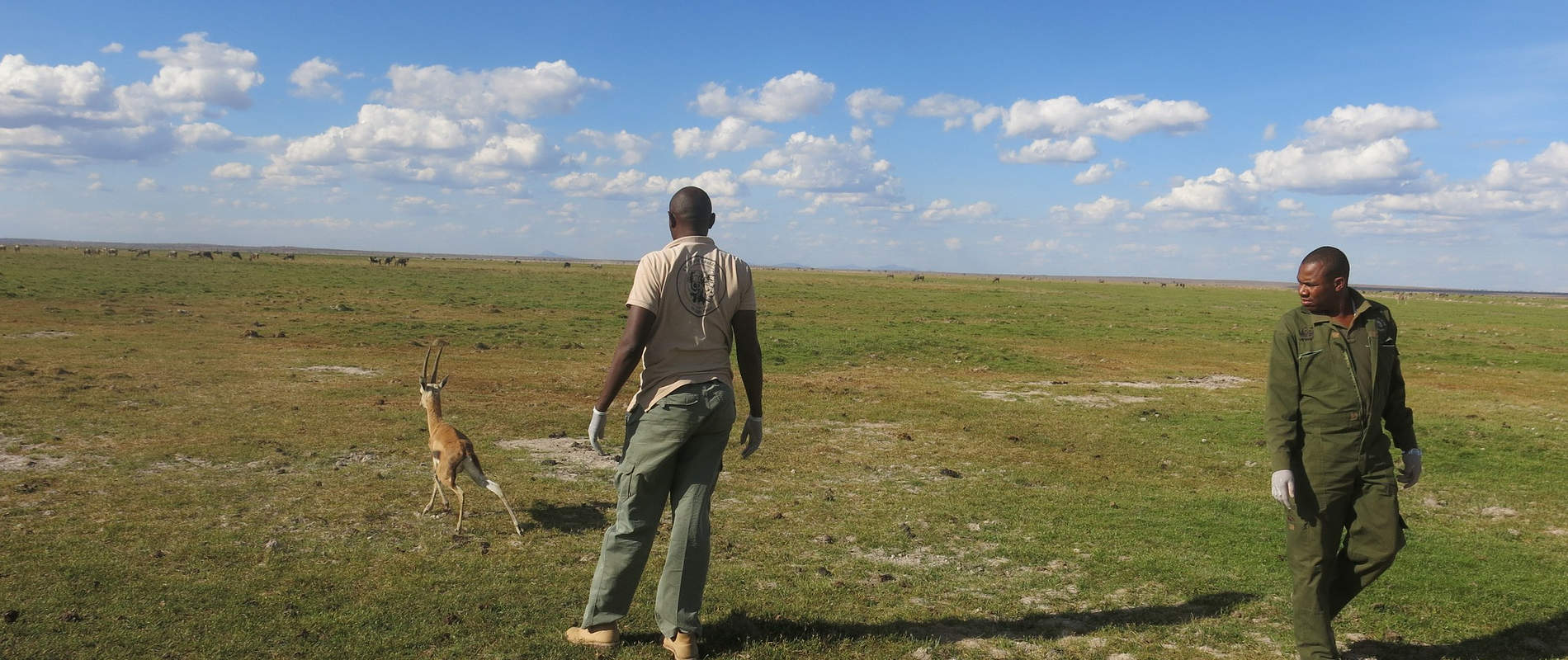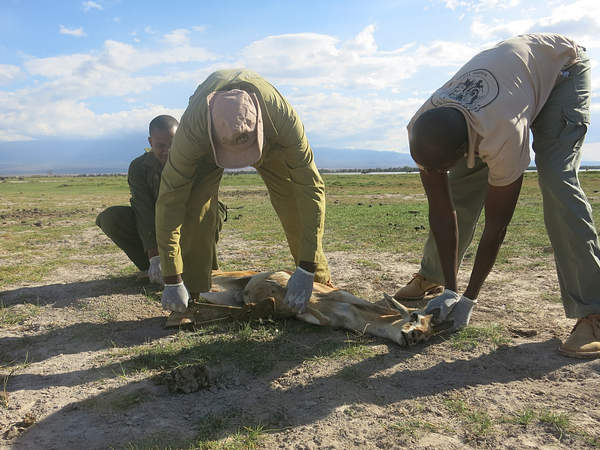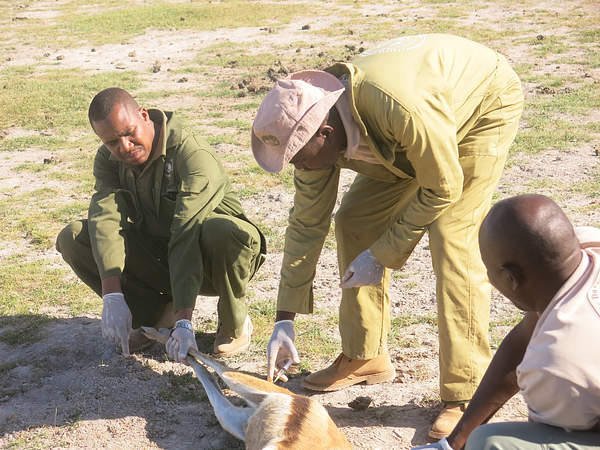Amboseli Mobile Veterinary Unit (AMVU) attended to six wildlife cases during November 2018. All animals (a wildebeest, a Thompson’s gazelle, an Impala, and Grant’s gazelle) were treated for different illnesses while an elephant was examined for cause death. The cause of death for the elephant examined was non specific but probably related to a puncture wound on the right side of the flank. A lion rescued from a community retailatory attack at Olgulului Group Ranch was moved to a safer territory in Tsavo West National Park.
CASE#1: POST-MORTEM EXAMINATION OF A FEMALE ELEPHANT
Date: 2nd November 2018
Species: Elephant (loxodonta africana)
Age: Adult
Sex: Female
Location; Tsavo West National Park, across Tsavo River
History: KWS Rangers based at Tsavo West reported a dead elephant to AMVU on 1/11/2018. Kamungi Conservancy Rangers directed and assisted the AMVU in accessing the carcass and site for the necropsy. The elephant had no tusks as KWS rangers had removed them for custody.
Examination and Findings:
Gross Observations: The carcass of a female elephant was found lying in a sternal position. The body had reasonable amount of ticks and flies. The carcass was bloated but, the weight appeared to be low in relation to the volume set by the structural bones. This observation is likely to be an indicator of poor body condition or emaciation before death. A small diameter penetrating wound was observed on the right side of the body. The wound was marked with elaborate sign of fluid discharges before death. No scavenging (hyena or vulture) activity was observed.
The carcass demonstrated an ongoing autolysis process and bacterial activity of the internal soft tissues. On cutting, water-like fluid flowed out in vast amounts from the carcass. The penetrating wound on the right side was cut through and followed to check for foreign bodies, but nothing was found. The wound was marked with massive adhesions of body tissues to the abdominal muscles and presence of pus deposits.
A biomass of immature larvae (maggots) was found in the lower parts of the body penetrating the lower abdominal wall. The carcass’ internal organs (liver and lungs) were decomposed and demonstrated a dark color change in the liver. The flies colonising the carcass indicated the carcass was 3 days old. Presence of immature larvae on the body, flesh watery fluids, and beetles supported this conclusion.

Cause of death: The cause was non-conclusive. The carrion was decomposed and deficient of information that could lead to a specific cause of death. However, the carcass demonstrated significant damage around the wound.
CASE#2: TREATMENT OF A LAME WILDEBEEST
Date: 3rd November 2018
Species: Blue wildebeest (Connochaetes taurinus)
Age: Adult
Sex: Male
Location; Kiltome Conservancy
History: Big Life rangers stationed at Tawi lodge/camp reported a lame wildebeest to AMVU on the 3rd November.
Immobilization, examination and treatment: The wildebeest was located and darted from a vehicle with 5mg Etorphine Hcl and 60mg Azaperone. The wildebeest reached recumbent anesthesia in 7 minutes and was placed on lateral recumbency. The wildebeest was treated with 20ml of Amoxicillin (Betamox) to prevent secondary infection through the darting wound and 10ml Cortisone to ease the pain.
Reversal and Prognosis: The anesthetic was reversed with an intravenous injection of Diprenorphine. Prognosis was good as there were no complications due to the injury.
CASE#3: POSTMORTEM OF A GRANT'S GAZELLE
Date: 3rd November 2018
Species: Grant’s gazelle (Nanger granti)
Age: Adult
Sex: Female
Location; Kiltome conservancy
History: A dead Grants Gazelle was sighted by the AMVU while on the way to treat a lame wildebeest at Kiltome Conservancy.
Examination and findings: The gazelle was observed to have been in good body condition before death. No abnormalities were noted in any of the internal body organs apart from a few worms. Nonetheless, the worms discovered were within the range of what would be found if the animal was in reasonable health. Characteristic to the case was a cervical bone break which can be explained by the signs of pre-death struggle, evident on the ground where the gazelle laid dead.

Cause of death: Self-inflicted strangulation.
CASE#4: TREATMENT OF A LAME IMPALA
Date: 6th November 2018.
Species: Impala (Aepyceros melampus)
Age: Adult
Sex: Female
Location: Amboseli National Park
History: AMVU noted the case during Park patrol.
Immobilization, examination and treatment: The impala was located and darted from a vehicle using 1mg Etorphine Hcl and reached recumbent anesthesia 5 minutes after darting. The animal was placed on lateral recumbency for ease of examination and treatment. The impala was treated with 10ml of Amoxicillin (Betamox LA®) and 10ml Dexamethasone to prevent secondary bacterial infection and ease pain.

Reversal and Prognosis: Intravenous injection with Diprenorphine revived the animal. Prognosis was good as there were no other complications.
Our mobile vet initiative is in the field every day saving wild lives
CASE#5: TREATMENT OF A FRAIL AND LAME THOMPSON GAZELLE
Date: 8th November 2018
Species: Thompson’s gazelle
Age: Adult
Sex: Male
Location: Amboseli National Park
History: AMVU noted the case during a Park patrol.
Immobilization, examination and treatment: This Thompson’s gazelle was located and darted from a vehicle using 1mg Etorphine Hcl. The gazelle reached recumbent anesthesia 5 minutes after darting.

The gazelle had overgrown hooves and mange like skin infection. The gazelle was treated with 5ml of Amoxicillin (Betamox LA®), 1ml Ivomectin and 3ml Dexamethasone. The hooves were cut short and to size using hoof trimmers.
Reversal and Prognosis: The anesthetic was reversed using an Intravenous injection of Diprenorphine. Prognosis was good, and the animal was expected to recover.
Acknowledgment
Report by KWS Vet Dr Kariuki. We thank David Sheldrick Wildlife Trust (DSWT) for material support and Mobile Unit funding, KWS for logistical support and security. DWST and Big Life Foundation rangers for reporting and monitoring of distressed wild animals. We are always grateful for your help in conservation in Kenya.



